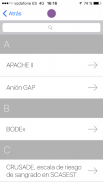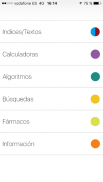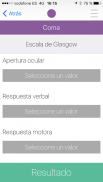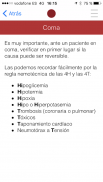







URG

Description of URG
The contents of URG are grouped in subjects such as: Guiding Symptoms, Vital Emergencies, Cardiology, Vascular Surgery, Respiratory, Neurology and Neurosurgery, Nephrology and Urology, Digestology and General Surgery, Infections, Endocrinology, Toxicology, Oncohematology, Rheumatology, Ophthalmology, Otolaryngology , Gynecology, Dermatology, Psychiatry, Geriatrics, Pediatrics, Miscellaneous. In each of these sections there are different chapters or protocols -more than one hundred and forty, with texts, algorithms, calculating scales and bibliography- that address the most common situations in Emergency and Emergency Medicine.
In URG you can navigate through its interactive algorithms that allow you to approximate a diagnosis from symptoms such as coma, syncope, chest pain, dyspnea, acute neurological focal, abdominal pain, fever, headache, hemoptysis, hematuria, diarrhea; or on the management of serious pathologies, such as different types of shock, abdominal and thoracic aneurysm, head trauma and others; you also have algorithms on such prevalent pathologies as atrial fibrillation, the exacerbation of COPD or the main infectious diseases. In the URG app you will find a total of 185 diagnostic, management or treatment algorithms.
Another benefit of URG of great interest for professionals of emergency and hospital emergencies and extrahospitalarias is the facility for the calculation of scales, either predictive or risk scores or numerical calculators. URG has a total of 115 calculators and scales that calculate immediately and propose the decision that is derived in case of being a predictive score.
Here are some of the scales and calculators:
Glasgow and Four Scales, EGSYS, OESIL, Canadian Syncope Risk Score, Boston Scale of Syncope Risk, Geleijnse Scale for Clinical Diagnosis of Ischemic Chest Pain, NYHA Heart Failure Scale of Dyspnea, Risk of stroke after TIA: ABCD2, APACHE II scale, calculator for the conversion of micrograms / Kg / minute to infusion ml / h, SOFA and Q-SOFA, Hemorrhagic shock: Assessment of Blood Consumption (ABC) score, Trauma Score and Revised Trauma Score, NYHA dyspnea scale in heart failure, TIMI Score for SCASEST, TIMI Score in SCACEST, CRUSADE, scale of risk of bleeding in NSTE-ACS, Grace Scale (SCA mortality), Cardioembolic Risk: CHA2DS2VASC, Scale of hemorrhagic risk HASBLED, Wells scale: clinical probability of DVT, calculation of DVT risk and indication of prophylaxis, Padua scale for the evaluation of VTD in hospitalized patients, Interference claudication questionnaire Edinburgh, BODE severity scale, BODEx, Modified dyspnea scale mMRC ... and so on up to 115 scales and calculators.
You also have a pharmaceutical guide with a summary of the technical specifications of all the drugs included in the different chapters, so that when a drug is mentioned, you can quickly access the contents of the summary of the technical sheet.
All the contents of URG are linked to each other, the texts, the algorithms, the scales and the calculators, as well as the drugs, which helps the URG user to access very quickly to the knowledge that prevails for daily practice.
Finally, URG is constantly evolving and updating. The scientific committee of URG is formed by leading professionals of opinion in Emergencies and Emergencies. However, if users have any suggestions about the operation or the contents, they can go to the email naaxxpot@gmail.com.
The scientific committee that reviews and updates the contents is made up of opinion leaders in Emergency and Emergency Medicine, which ensures the validity of the contents and their permanent updating.






















